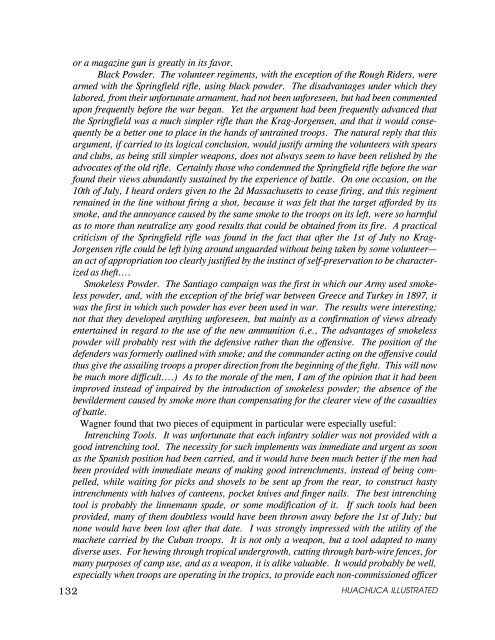Turn of the Century - Fort Huachuca - U.S. Army
Turn of the Century - Fort Huachuca - U.S. Army
Turn of the Century - Fort Huachuca - U.S. Army
- No tags were found...
Create successful ePaper yourself
Turn your PDF publications into a flip-book with our unique Google optimized e-Paper software.
or a magazine gun is greatly in its favor.Black Powder. The volunteer regiments, with <strong>the</strong> exception <strong>of</strong> <strong>the</strong> Rough Riders, werearmed with <strong>the</strong> Springfield rifle, using black powder. The disadvantages under which <strong>the</strong>ylabored, from <strong>the</strong>ir unfortunate armament, had not been unforeseen, but had been commentedupon frequently before <strong>the</strong> war began. Yet <strong>the</strong> argument had been frequently advanced that<strong>the</strong> Springfield was a much simpler rifle than <strong>the</strong> Krag-Jorgensen, and that it would consequentlybe a better one to place in <strong>the</strong> hands <strong>of</strong> untrained troops. The natural reply that thisargument, if carried to its logical conclusion, would justify arming <strong>the</strong> volunteers with spearsand clubs, as being still simpler weapons, does not always seem to have been relished by <strong>the</strong>advocates <strong>of</strong> <strong>the</strong> old rifle. Certainly those who condemned <strong>the</strong> Springfield rifle before <strong>the</strong> warfound <strong>the</strong>ir views abundantly sustained by <strong>the</strong> experience <strong>of</strong> battle. On one occasion, on <strong>the</strong>10th <strong>of</strong> July, I heard orders given to <strong>the</strong> 2d Massachusetts to cease firing, and this regimentremained in <strong>the</strong> line without firing a shot, because it was felt that <strong>the</strong> target afforded by itssmoke, and <strong>the</strong> annoyance caused by <strong>the</strong> same smoke to <strong>the</strong> troops on its left, were so harmfulas to more than neutralize any good results that could be obtained from its fire. A practicalcriticism <strong>of</strong> <strong>the</strong> Springfield rifle was found in <strong>the</strong> fact that after <strong>the</strong> 1st <strong>of</strong> July no Krag-Jorgensen rifle could be left lying around unguarded without being taken by some volunteer—an act <strong>of</strong> appropriation too clearly justified by <strong>the</strong> instinct <strong>of</strong> self-preservation to be characterizedas <strong>the</strong>ft....Smokeless Powder. The Santiago campaign was <strong>the</strong> first in which our <strong>Army</strong> used smokelesspowder, and, with <strong>the</strong> exception <strong>of</strong> <strong>the</strong> brief war between Greece and Turkey in 1897, itwas <strong>the</strong> first in which such powder has ever been used in war. The results were interesting;not that <strong>the</strong>y developed anything unforeseen, but mainly as a confirmation <strong>of</strong> views alreadyentertained in regard to <strong>the</strong> use <strong>of</strong> <strong>the</strong> new ammunition (i.e., The advantages <strong>of</strong> smokelesspowder will probably rest with <strong>the</strong> defensive ra<strong>the</strong>r than <strong>the</strong> <strong>of</strong>fensive. The position <strong>of</strong> <strong>the</strong>defenders was formerly outlined with smoke; and <strong>the</strong> commander acting on <strong>the</strong> <strong>of</strong>fensive couldthus give <strong>the</strong> assailing troops a proper direction from <strong>the</strong> beginning <strong>of</strong> <strong>the</strong> fight. This will nowbe much more difficult....) As to <strong>the</strong> morale <strong>of</strong> <strong>the</strong> men, I am <strong>of</strong> <strong>the</strong> opinion that it had beenimproved instead <strong>of</strong> impaired by <strong>the</strong> introduction <strong>of</strong> smokeless powder; <strong>the</strong> absence <strong>of</strong> <strong>the</strong>bewilderment caused by smoke more than compensating for <strong>the</strong> clearer view <strong>of</strong> <strong>the</strong> casualties<strong>of</strong> battle.Wagner found that two pieces <strong>of</strong> equipment in particular were especially useful:Intrenching Tools. It was unfortunate that each infantry soldier was not provided with agood intrenching tool. The necessity for such implements was immediate and urgent as soonas <strong>the</strong> Spanish position had been carried, and it would have been much better if <strong>the</strong> men hadbeen provided with immediate means <strong>of</strong> making good intrenchments, instead <strong>of</strong> being compelled,while waiting for picks and shovels to be sent up from <strong>the</strong> rear, to construct hastyintrenchments with halves <strong>of</strong> canteens, pocket knives and finger nails. The best intrenchingtool is probably <strong>the</strong> linnemann spade, or some modification <strong>of</strong> it. If such tools had beenprovided, many <strong>of</strong> <strong>the</strong>m doubtless would have been thrown away before <strong>the</strong> 1st <strong>of</strong> July; butnone would have been lost after that date. I was strongly impressed with <strong>the</strong> utility <strong>of</strong> <strong>the</strong>machete carried by <strong>the</strong> Cuban troops. It is not only a weapon, but a tool adapted to manydiverse uses. For hewing through tropical undergrowth, cutting through barb-wire fences, formany purposes <strong>of</strong> camp use, and as a weapon, it is alike valuable. It would probably be well,especially when troops are operating in <strong>the</strong> tropics, to provide each non-commissioned <strong>of</strong>ficer132 HUACHUCA ILLUSTRATED
















